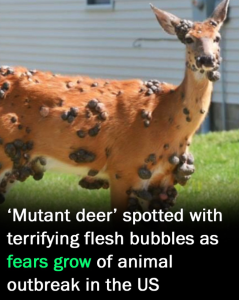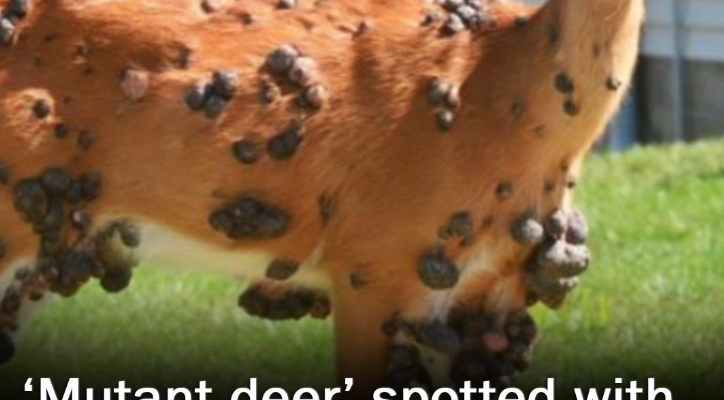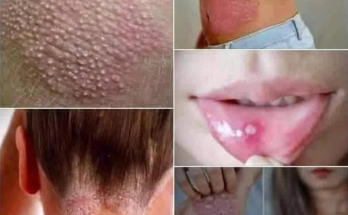‘Mutant Deer’ With Bubble Skin Sparks Outbreak Fears in U.S.
When a hunter in the rural woods of the Midwest stumbled across a deer unlike any he had ever seen, he thought at first his eyes were deceiving him. The animal’s skin appeared to be covered in blister-like swellings, large bubbles that distorted its natural shape and gave it a grotesque, almost mutant appearance. Photos of the deer quickly circulated online, sparking horror, fascination, and an immediate wave of concern: was this the beginning of a new wildlife disease outbreak in the United States?
The First Sightings
The first reports came from a group of hunters in late summer. They described the deer as having “skin like bubble wrap,” with pockets of fluid protruding beneath the surface. The animal appeared sluggish and disoriented, moving slower than normal and stopping often to scratch at its own body. For the men who had been hunting deer all their lives, it was a deeply unsettling sight. One hunter told local reporters, “I’ve seen deer with mange, with ticks, with broken antlers, but nothing like this. It looked like something out of a science fiction movie.”
Within days, images and shaky video footage made their way to social media, where the term “mutant deer” quickly trended. Speculation spread like wildfire: was this a genetic mutation, a reaction to pesticides, or evidence of a new animal-borne virus?
Wildlife Officials Step In
Local wildlife agencies confirmed that they had retrieved at least two carcasses showing similar symptoms. Samples were immediately sent to state laboratories for testing. Officials assured the public that they were investigating every possibility—from bacterial infections to parasitic infestations—but they acknowledged that the visuals alone were alarming enough to warrant serious attention.
“We want to be clear: there is no evidence at this time that this is a threat to humans,” one spokesperson said. “However, whenever we see unusual patterns in wildlife health, we must take it seriously. Diseases that affect deer can sometimes cross into livestock populations, and in rare cases, into humans.”
That statement did little to calm fears. Memories of other zoonotic outbreaks—rabies, West Nile virus, chronic wasting disease (CWD), and even COVID-19—loomed large in the public imagination.
Possible Explanations
Veterinarians and wildlife biologists proposed several working theories:
-
Parasitic cysts or infections – Deer are often hosts to parasites. In rare cases, certain worms or botflies can cause cyst-like swellings beneath the skin. These could appear as bubbles when multiple infestations spread.
-
Severe case of papillomavirus – White-tailed deer are known to contract cutaneous fibromas, a type of wart-like growth caused by a virus. Normally small and harmless, in extreme cases they can cover large parts of the body, giving the animal a grotesque appearance.
-
Chemical exposure – Runoff from agricultural chemicals or pollutants might cause unusual skin reactions in wildlife. Experts did not rule out the possibility of toxins creating blistering or bubble-like swellings.
-
A new or mutated disease – This was the theory that captured the most public attention. People feared that a previously unknown pathogen was emerging, one that might jump from deer to other animals—or even to humans.
Public Reaction
The images triggered widespread anxiety, particularly in rural communities where hunting is both a tradition and a food source. Some hunters worried about whether venison was safe to eat. Others wondered if simply touching or skinning a deer could put them at risk.
Social media posts amplified the panic. Some users compared the deer to “walking biohazards,” while others spread conspiracy theories about government experiments or secret viral leaks. Hunting forums were flooded with questions like: If I see one of these deer, should I report it? Should I shoot it? Should I run the other way?
Grocery shoppers in certain areas even reported avoiding venison products in fear of contamination, despite officials insisting there was no confirmed link to food safety.
Memories of Chronic Wasting Disease
The outbreak fears were fueled by America’s ongoing struggle with Chronic Wasting Disease (CWD), sometimes called “zombie deer disease.” CWD, caused by prions, has spread steadily across deer populations in multiple states, raising alarm among scientists about its potential long-term impact. Although CWD has not yet crossed into humans, the Centers for Disease Control and Prevention (CDC) have issued cautions about eating venison from infected animals.
To the public, the sight of deer with bubble-like skin seemed to echo those same worries—another potential wildlife epidemic emerging without warning.
Experts Urge Caution, Not Panic
Despite the shocking images, most experts stressed that people should not jump to catastrophic conclusions. Wildlife pathologists noted that unusual growths or deformities in individual deer are not unheard of. Often, they result from localized infections, genetic defects, or injuries. What made this case stand out was the extremity of the visible symptoms and the clustering of multiple reports in a short time frame.
Dr. Hannah Lewis, a veterinary epidemiologist, told local media: “Yes, it looks shocking. Yes, it’s unusual. But before we assume this is the start of an epidemic, we need data. Deer populations are large, and sometimes rare conditions appear in clusters. That doesn’t automatically mean we’re dealing with a new pathogen.”
She emphasized that hunters who encounter abnormal-looking animals should avoid handling them and contact wildlife authorities immediately.
The Broader Issue
The incident also reignited discussions about the growing interactions between humans, livestock, and wildlife. As development pushes deeper into natural habitats, the chances of disease spillover increase. Deer, in particular, thrive in suburban and rural landscapes, often living in close proximity to farms, gardens, and even backyards.
A wildlife ecologist explained, “Deer are a bridge species. They move freely between wild spaces and human spaces. If they carry unusual pathogens, the risk of cross-species transmission is always present. That’s why monitoring them is so important.”
What Happens Next
As of now, labs continue testing the affected deer to identify the root cause. Officials are urging hunters to:
-
Report any sightings of deer with abnormal growths.
-
Avoid consuming meat from visibly sick animals.
-
Wear gloves when handling carcasses.
-
Stay updated on state wildlife advisories.
If the phenomenon is traced to parasites or common infections, the scare may fade quickly. But if evidence points to a new viral or bacterial agent, the discovery could trigger broader surveillance programs across the country.
The Symbolism of the “Mutant Deer”
Beyond the biological questions, the “mutant deer” has become a symbol of public unease. It reflects a society still on edge after years of pandemic struggles, wary of the next unseen threat that might emerge from the natural world.
For some, the deer represented a haunting reminder of humanity’s fragile relationship with nature: a wild creature transformed into a grotesque warning sign, its bubble-like skin mirroring the fragility of ecological balance.
As one local resident put it after seeing the photos: “Maybe it’s just a sick deer. Or maybe it’s nature’s way of telling us something’s wrong.”


